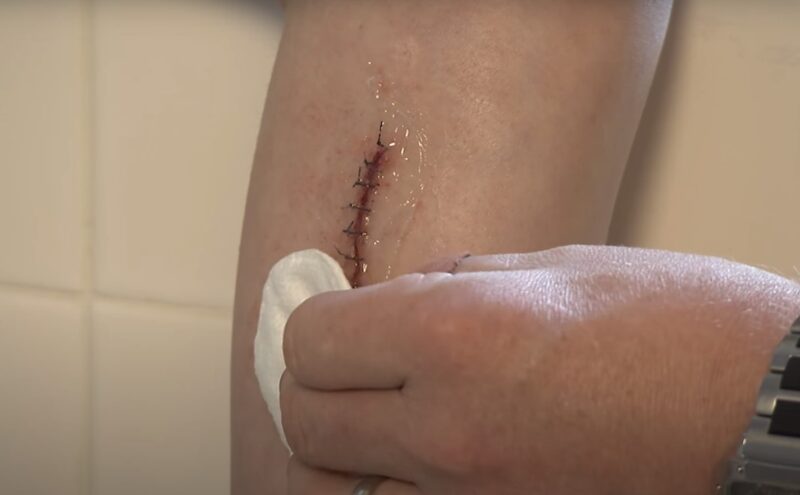When you get a wound, it undergoes distinct stages of healing. Generally, small wounds heal faster than larger, deeper ones. However, the type of dressings used, your overall health, and other factors also influence the healing time.
Medical professionals often categorize wound healing into three phases: inflammatory, proliferation, and maturation. But these terms might not clearly describe what you’ll physically see during healing.
It’s important to be aware of the physical signs of healing to ensure that your wound is recovering properly and on time.
Bleeding

Bleeding is a common response to many types of wounds, particularly punctures. However, not every wound bleeds. For example, burns and pressure sores typically don’t involve bleeding. In cases of puncture wounds, the body’s immediate response is to stop the bleeding.
This is achieved through the blood clotting process. Within a few minutes of injury, blood clots start to form, effectively slowing and eventually stopping the bleeding. After the bleeding stops, the clot begins to dry and harden, forming a scab over the wound.
This scab acts as a protective barrier, shielding the wound from infection and allowing the underlying tissue to heal. Excessive bleeding or the inability to form a scab, even after a minor puncture, cut, or scrape, is a cause for concern. This could indicate a problem with the blood’s ability to clot.
Conditions like hemophilia or certain medications can disrupt normal clotting. People experiencing these symptoms should seek medical attention. Prompt evaluation and treatment are important to address any underlying medical issues and ensure proper wound healing.
Swelling

Swelling is a natural part of the body’s healing process after a wound occurs. Once a scab forms over the wound, the body’s immune system kicks into action. The area around the wound becomes swollen and tender, which is a normal response to injury.
This swelling is due to the body increasing blood flow to the area. Increased blood flow brings necessary nutrients and oxygen to aid in healing. During this stage, you might notice the wound secreting a clear fluid. This is not a cause for alarm. It’s the body’s way of cleaning the wound area, flushing out any debris or bacteria.
This fluid release is a crucial part of the healing process. Additionally, the color of the affected area often changes. It may turn reddish or pinkish. This change in color is due to the blood vessels in the area dilating or expanding. This vascular response ensures that more blood, carrying oxygen and nutrients, reaches the wound site.
This stage of healing typically lasts from 2 to 5 days. During this time, white blood cells play a vital role. They are actively fighting any potential infection and are integral to repairing the tissue in the wound bed. The presence of these white blood cells is critical for preventing infection and promoting effective healing of the wound.
Tissue re-growth

Tissue re-growth is a critical phase in the wound healing process, typically commencing around five days after the injury. This stage, also known as the proliferation stage, can last about three weeks for minor wounds. During this period, the body undertakes significant repair work.
One of the key tasks is repairing broken blood vessels. These vessels are essential for delivering blood, which carries oxygen and nutrients vital for healing, to the wound area. Simultaneously, the body works to replace the damaged tissue with new, healthy tissue.
This new tissue, known as granulation tissue, is soft, pink, and somewhat bumpy in appearance. It’s rich in collagen and blood vessels, crucial components for rebuilding the wound area. The formation of granulation tissue is a positive sign, indicating that the body’s healing processes are working effectively.
Over time, this granulation tissue gets covered by a new layer of skin. As the healing process progresses, the skin around the wound starts to contract. This contraction pulls the edges of the wound inward, making the wound smaller. This natural progression is a crucial part of the healing process, leading to the eventual closure of the wound.
Scar formation
Scar formation is the final stage in the wound healing process and can extend up to two years. During this stage, known as the maturation or remodeling phase, the appearance and texture of the wound area undergo significant changes.
As the scab, which formed earlier in the healing process, falls off, the underlying area often appears red, stretched, and shiny. This is a normal part of the skin’s healing and rejuvenation. One common experience during this stage is itching. As the new skin forms and the scar matures, it’s not uncommon for the area to feel itchy.
This sensation is a part of the natural healing process. The scar that forms is typically smaller than the original wound. This reduction in size happens as the skin contracts and the wound closes up. It’s important to note that the scarred skin is different from the surrounding skin.
It tends to be weaker and less flexible. This difference is due to the way the granulation tissue, which formed in the earlier stage, rebuilds the area. The new tissue is composed primarily of collagen, a protein that provides strength but less elasticity compared to normal skin.
FAQs
Can you feel a wound healing?
Yes, you might feel sensations like tingling, itching, or slight discomfort as a wound heals. These feelings are normal and indicate the body’s healing process.
Do wounds heal faster covered or uncovered?
Most wounds heal faster when covered. A bandage keeps the wound moist, protects against bacteria, and prevents scab formation, all of which promote quicker healing.
How do you know if a wound is not healing?
Signs of a non-healing wound include persistent pain, redness, swelling, foul odor, or discharge. If the wound doesn’t improve or gets worse over time, it’s not healing properly.
How to heal wounds faster?
To speed up healing, keep the wound clean and moist, apply appropriate dressings, avoid picking at it, eat a balanced diet, and follow your doctor’s advice on wound care.
The Bottom Line
Wound healing is a complex process that occurs in stages: hemostasis, inflammation, proliferation, and maturation. Each stage plays a crucial role in repairing the damaged tissue. Recognizing the signs of these stages helps in understanding the healing process.
Proper care and treatment are essential for effective healing. If a wound does not progress through these stages as expected, it may indicate an issue that requires medical attention. Understanding the signs and stages of wound healing is important for effective wound management and overall health.







